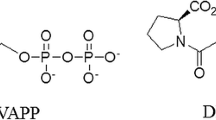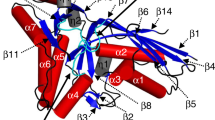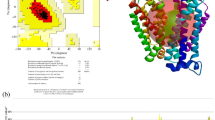Abstract
Mevalonate 5-diphosphate decarboxylase (MVD) is an important enzyme in the mevalonate pathway catalyzing the ATP-dependent decarboxylation of mevalonate 5-diphosphate (MDP) to yield isopentynyl diphosphate (IPP) which is an ubiquitous precursor for isoprenoids and sterols. Although there are studies to show the involvement of certain amino acid residues in MVD activity, the structure and the function of the active site is yet to be investigated. Therefore the objectives of this study were to elucidate the active site of Saccharomyces cerevisiae MVD (scMVD) using a molecular docking and simulation-based approach. The Cartesian coordinates of scMVD retrieved from the PDB database were used in the docking procedure. 3D atomic coordinates of MDP, ATP and an inhibitor trifluoromevalonate (TFMDP) were generated using Gaussian 98. ATP, MDP and TFMDP were docked into the potential active site identified by sequence analyses using Hex 4.2. The complexes obtained from docking procedure were subjected to 1.5 ns simulation by GROMACS 3.2. Investigation of complexes revealed that Ala15, Lys18, Ser121 & Ser155; Lys22, Ser153 & Ser155 and Tyr19, Ser121, Ser153, Gly154 & Thr209 of MVD are within hydrogen bond forming distances of MDP, ATP and TFMDP, respectively indicating their possible involvement in active site formation through H-bond formation. The presence of a water molecule between the carboxyl group of Asp302, a previously characterized active site residue and C3 region of MDP at a distance of 3 Å suggests that deprotonation of the hydroxyl of the C3 takes place via a water molecule. Conjunction with reported crucial catalytic activity of Ser121 of MVD and our finding of the presence of this residue in hydrogen bond forming distance to MDP suggests that this hydrogen bond helps in proper orienting of MDP for phosphorylation /decarboxylation. We further suggest that the reported greater RMS deviation of Pro79- Leu mutated MVD with respect to native MVD of temperature sensitive mutant phenotype of S. cerevisiae is due to partial unfolding of MVD as a result of mutation. Finally, this study provides a tantalizing glimpse about hitherto unknown structural and functional properties of the active site of MVD.












Similar content being viewed by others
References
Rohmer M, Knani M, Simonin P, Sutter B, Sahm H (1993) Isoprenoid biosynthesis in bacteria: a novel pathway for the early steps leading to isopentenyl diphosphate. Biochem J 295:517–524
Edwards PA, Ericsson J (1999) Sterols and isoprenoids: signaling molecules derived from the cholesterol biosynthetic pathway. Annu Rev Biochem 68:157–185
Eisenreich W, Arigoni D, Bacher A, Rohdich F (2004) Biosynthesis of isoprenoids via the nonmevalonate pathway. Cell Mol Life Sci 6:1401–1426
Hunter WN (2007) Structure and reactivity in the non-mevalonate pathway of isoprenoid biosynthesis. J Biol Chem 282:21573–21577
Goldstein JL, Brown MS (1990) Regulation of the mevalonate pathway. Nature 343:425–430
Lichtenthaler H (1999) The 1-Deoxy-D-xylulose-5-phosphate pathway of isoprenoid biosynthesis in plants. Annu Rev Plant Physiol Plant Mol Biol 50:47–65
Rohmer M (1999) The discovery of a mevalonate-independent pathway for isoprenoid biosynthesis in bacteria, algae and higher plants. Nat Prod Rep 16:565–574
Rodriguez-Concepcion M, Boronat A (2002) Elucidation of the methylerythritol phosphate pathway for isoprenoid biosynthesis in bacteria and plastids. A metabolic milestone achieved through genomics. Plant Physiol 130:1079–1089
Bailey AM, Mahapatra S, Brennan PJ, Crick DC (2002) Identification, cloning, purification, and enzymatic characterization of Mycobacterium tuberculosis 1-deoxy-D-xylulose 5-phosphate synthase. Glycobiol 12:813–820
Chappell J (1995) Biochemistry and molecular biology of the isoprenoid biosynthetic pathway in plants. Annu Rev Plant Physiol Plant Mol Biol 46:521–547
Sacchettini JC, Poulter CD (1997) Creating isoprenoid diversity. Science 277:1788–1789
Rohmer M (1999) In: Barton D, Nakanishi K (eds) Comprehensive Natural Products Chemistry, vol 2. Elsevier , Amsterdam, pp 45–67
Kuzuyama T, Seto H (2003) Diversity of the biosynthesis of the isoprene units. Nat Prod Rep 20:171–183
Berges T, Guyonnet D, Karst F (1997) Characterisation of a Leu-to- Pro mutation in a conserved sequence of mevalonate diphosphate decarboxylase in yeast. J Bacteriol 179:4664–4670
Jabalquinto AM, Alvear ME, Cardemil E (1988) Physiological aspects and mechanism of action of mevalonate 5-diphosphate decarboxylase. Comp Biochem Physiol 9OB:671–677
Byres E, Alphey MS, Smith TK, Hunter WN (2007) Crystal structures of Trypanosoma brucei and Staphylococcus aureus mevalonate diphosphate decarboxylase inform on the determinants of specificity and reactivity. J Mol Biol 371:540–553
Dassanayake RS, Cao L, Samaranayake LP, Berges T (2002) Characterization, heterologous expression and functional analysis of mevalonate diphosphate decarboxylase gene (MVD) of Candida albicans. Mol Genet Genomics 267:281–290
Cordier H, Karst F, Berges T (1999) Heterologous expression in Saccharomyces cerevisiae of an Arabidopsis thaliana cDNA encoding mevalonate diphosphate decarboxylase. Plant Mol Biol 39:953–967
Bonanno JB, Edo C, Eswar N, Pieper U, Romanowski MJ, Ilyin Y, Gerchman SE, Kycia H, Studier FW, Sali A et al (2001) Structural genomics of enzymes involved in sterol/isoprenoid biosynthesis. Proc Natl Acad Sci 98:12896–12901
Krepkiy D, Miziorko HM (2004) Identification of active site residues in mevalonate diphosphate decarboxylase: Implications for a family of phosphotransferases. Protein Science 13:1875–1881
Krepkiy DV, Miziorko HM (2005) Investigation of the functional contributions of invariant serine residues in yeast mevalonate diphosphate decarboxylase. Biochem 44:2671–2677
Reardon JE, Abeles RH (1987) Inhibition of cholesterol biosynthesis by fluorinated mevalonate analogues. Biochem 26:4717–4722
Castillo M, Martinez-Cayuela M, Zafra MF, Garcia-Peregrin F (1991) Effect of phenylalanine derivatives on the main regulatory enzymes of hepatic cholesterogenesis. Mol Cell Biochem 105:21–25
Altschul SF, Warren G, Webb M, Eugene WM, David JL (1990) Basic local alignment search tool. J Mol Biol 215:403–410
Berman HM, Westbrook J, Feng Z, Gilliland G, Bhat TN, Weissig H, Shindyalov IN, Bourne PE (2000) The protein data bank. Nucl Acid Res 28:235–242
Mustard D, Ritchie DW (2005) Docking essential dynamics eigenstructure. Proteins 60:269–274
Arnold K, Bordoli L, Kopp J, Schwede T (2006) The SWISS-MODEL workspace: a web-based environment for protein structure homology modeling. Bioinformatics 22:195–201
Berensdsen HJC, Grigera JR, Straatma TP (1987) The missing term in effective pair potentials. J Phys Chem 91:6269–6271
Scott WRP, Hunenberger PH, Tironi IG, Mark AE, Billeter SR, Fennen J, Torda AE, Huber T, Kruger P, van Gunsteren WF (1999) The GROMOS biomolecular simulation program package. J Phys Chem A 103:3596–3607
Frisch MJ, Trucks GW, Schlegel HB, Scuseria GE, Robb MA et al (1998) Gaussian Inc, Pittsburgh PA
Berendsen HJC, Postma JPM, van Gunsteren WF, DiNola A, Haak JR (1984) Molecular dynamics with coupling to an external bath. J Chem Phys 81:3684–3690
Hess B, Bekker H, Berendsen HJC, Fraaije JGEM (1997) LINCS: a linear constraint solver for molecular simulations. J Comput Chem 18:1463–1472
de Leeuw SW, Perram JW, Smith ER (1980) Simulation of electrostatic systems in periodic boundary conditions. I. Lattice sums and dielectric constants. Proc R Soc London, Ser A 373:27–56
Darden T, York D, Pedersen LJ (1993) Particle mesh Ewald: An N log (N) method for Ewald sums in large systems. J Chem Phys 98:10089–10092
van der Spoel D, Lindahl E, Hess B, Groenhof G, Mark AE, Berendsen HJC (2005) GROMACS: fast, flexible and free. J Comp Chem 26:1701–1719
Berendsen HJC, van der Spoel D, van Drunen R (1995) GROMACS: a message-passing parallel molecular dynamics implementation. Comp Phys Comm 91:43–56
Lindahl E, Hess B, van der Spoel D (2001) Package for molecular simulation and trajectory analysis. J Mol Mod 7:306–317
Dhe-Paganon S, Magrath J, Abeles RJ (1994) Mechanism of mevalonate pyrophosphate decarboxylase: evidence for a carbocationic transition state. Biochem 33:13355–13362
Acknowledgments
We acknowledge the Department of Chemistry, University of Colombo, Sri Lanka for providing us with computer facilities and software for this work. We thank scientists who worked on MVD and published in scientific journals or deposited their data in publicly available databases. We further thank the scientists who developed Molecular Biology Software programs and Bioinformatics tools used in this study and also Dr. N.V. Chandrasekharan, Department of Chemistry, University of Colombo, Sri Lanka, for critical reading of the manuscript.
Author information
Authors and Affiliations
Corresponding author
Rights and permissions
About this article
Cite this article
Weerasinghe, S., Samantha Dassanayake, R. Simulation of structural and functional properties of mevalonate diphosphate decarboxylase (MVD). J Mol Model 16, 489–498 (2010). https://doi.org/10.1007/s00894-009-0561-7
Received:
Accepted:
Published:
Issue Date:
DOI: https://doi.org/10.1007/s00894-009-0561-7




